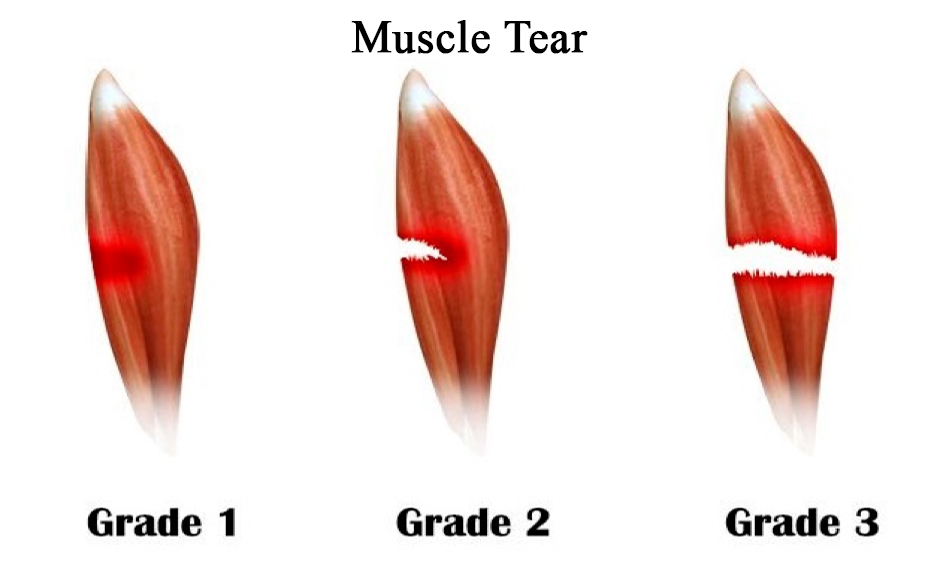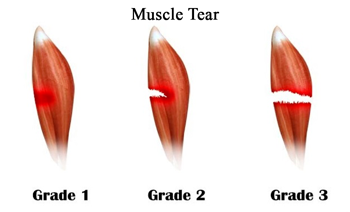A muscle tear is an acute injury caused by a laceration of the muscle cells/fibres and or tendon to which the muscle is attached to.
How can happen a muscle tear?
A muscle tear happens when a muscle is weak and don’t activate at the right time.
Weak muscles are common in repetitive movement or when a muscle overcompensates due to a fragile pattern.
For example, tearing a hamstring is expected when the Gluteal Firing pattern is incorrect.
This type of injury is common in sports activities. Still, it can also happen within a home environment by lifting a box incorrectly or during garden activities.
The three grades of muscle tear.
Grade 1 muscle tear is the mildest one.
As per this case, only a few muscle cells have been torn.
Symptoms are like:
- mild pain,
- moderate swelling,
- none or light bruising.
In grade 2, a moderate amount of muscle cells have been damaged.
Symptoms are like:
- Bruising is now more evident as per the swelling
- You must luckily hear a sound as the tear happens
- More severe pain, especially when trying to use that muscle.
Grade 3 is the worst-case scenario. In grade 3 muscle tear, the muscle has fully torn.
- Still, a pop or a sound would happen as the tear happens.
- On the opposite side of where the muscle did lacerate, you will notice a bulge as the muscle coiled up after tearing.
- Weakness in using the limb where the muscle got torn.
In case of a Grade 3 muscle tear, surgery is needed to reattach the muscle.
How to treat a muscle tear?
The immediate appliance of heat or cold packs is highly debated.
A cold pack would numb the area and help with the pain symptoms.
As mentioned in the “Ice Pack” blog post, that is actually recommended.
On the other hand, a heat pack would help stimulate blood circulation in the affected area, reduce swelling, and boost recovery.
It’s important to note that applying a heat pack too soon after an injury can actually make things worse. It’s best to wait until the acute phase has passed, which typically takes around 48 hours. At that point, heat therapy can be a helpful way to alleviate pain and promote healing.
Regarding massage treatments, MLD can be the only technique used as soon as the tear happens.
Indeed MLD would be highly recommended for boosting the recovery, especially in case of a tear in 3rd grade, where operation is needed.
In case of a 3rd-grade muscle tear, the first thing to do is see a doctor.
Other massage techniques, such as Myotherapy, Remedial Massage and Thai Massage, are still valuable for muscle tears.
On the other hand, either Myotherapy, Remedial or Thai Massage can only be practised after 48 hours of rest are passed after the incidents.
Indeed that 48 h is considered the acute phase of the muscle tear.
How to prevent a muscle tear?
More the body moves, the less the chance of injury.
Making sure to do simple exercises involving basic body movement can help in muscle tear prevention.
but not only.
Keeping the joint moving is another essential aspect of injury prevention.
How can massage help?
Along with a massage treatment, the area of focus will be the torn muscle and surrounding area.
Initially, the technique used with a massage treatment, especially for the injured area, would be MFTT and passive movement/mobilisation.
That would help muscle recovery and facilitate joint mobility, reducing the muscle’s load.
Going ahead with the treatments, techniques such as MET, a resisted muscle force technique, can be used.
This would allow the muscle to gain elasticity.



Giovanni La Rocca
Giovanni moved to Melbourne, Australia, from Italy in 2008 and became a citizen in 2017. He started studying massage therapy in 2016, then completed a Bachelor of Health Science in Clinical Myotherapy in August 2024. During those years, he also specialised in Thai Massage and Manual Lymphatic Drainage for presentations like Lipoedema and Lymphoedema. Nowadays, he runs his clinic in Fitzroy North, Melbourne, where he integrates movement therapy into his practice to enhance overall well-being. He also values meditation, having completed several Vipassana courses. Committed to continuous learning, he aims to share his expertise in integrated therapies to help others achieve balance and resilience.